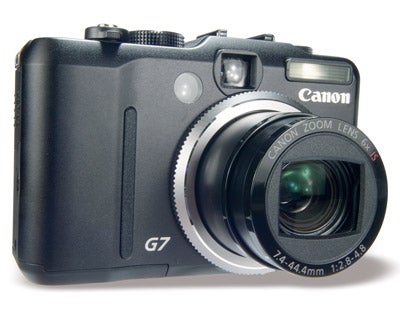Canon's flagship PowerShot model gets a makeover....
Canon PowerShot G7 Review
Since the launch of its G1 in 2000, Canon’s flagship PowerShot model has always been a ‘G series’ camera, combining the convenience of a fixed-lens compact with a feature set rivalling that of a digital SLR. However, with a complete rethink of both its design and content, the recently launched PowerShot G7 raises one simple question – is the newcomer a ‘true’ G series camera?
Features
On the face of it, Canon’s PowerShot G7 retains the basic G-series premise, with a 10MP sensor, three exposure metering patterns and a good selection of automatic and manual shooting modes. This is backed up by a generous 6x optical zoom equipped with Canon’s optical image stabilisation system and a sophisticated AF system comprising 9-point AiAF and FlexiZone 1-point focusing. The G7’s all-inclusive ISO range covers speeds of 80-1600 (compared to the G6’s ISO 50-400), with Canon’s latest Digic III processor claiming to reduce high ISO noise. Delving beyond its ‘headline-grabbing’ features, innovative additions to the G7 include face detection that’s said to optimise the focus and exposure for pictures containing up to nine faces, as well as ‘safety zoom’ and a ‘digital tele-converter’ to increase the zoom range up to 24x. Yet undermining this high-end cocktail is one significant omission – the G7 can’t record RAW files. RAW capture was one of the G series’ key features, setting it apart from other PowerShot models, and elevated it above many of the high-end offerings from other manufacturers. Without RAW, the G7 arguably loses one of its major selling points.
Design
Instead of a Vari-angle display, the G7 uses a conventional fixed LCD, although this may not be a bad thing. As well as being physically larger, the 2.5in LCD has a wider viewing angle for better preview and playback functionality, and the fixed design has allowed a radically different look and feel. Gone is the right-hand finger grip and top-mounted control wheel, leaving a slimmed-down black, metal-bodied camera that feels solid.
Up top there’s now a dedicated ISO dial to make changing sensitivity incredibly easy, while on the back many of the G7’s controls are found in a neat triple-action ‘control centre’. This uses a rotating wheel on the outside, a four-way rocker switch within this, and in the centre is a small function/set button. The system generally works well, even though it takes a bit of getting used to.
Image Quality
With so many pixels crammed into such a small area, greater amplification of the signal is needed, resulting in a high base level of noise. At ISO 800-1600, you can expect noticeable degradation of detail and ‘ragged’ edges. Even at ISO 200 fine detail such as hair can start to ‘disappear’ into a flat patch, as the pattern exceeds the resolving power of sensor and the noise reduction further smoothes the image. However, the exposures delivered by the G7’s evaluative metering pattern are excellent and the automatic white balance produces an acceptable result.
Value For Money
For the G7’s £449 asking price you get a reassuringly solid compact camera that offers a DSLR-style feature set. However, the price puts it in EOS 400D territory, and as there’s no RAW mode it begins to look a little pricey.
Verdict
The question of whether the G7 is a 'true' G series camera is largely academic and, in fairness, the new model improves on the G6 in almost every area. But - and this is a big BUT - it is let down by image quality, which is all the more disappointing because of the lack of a RAW option. Fewer pixels and a RAW mode could have made this the ultimate digital compact.





